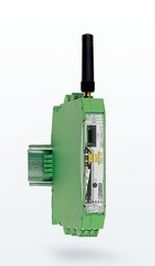
Transmit serial data reliably even in difficult environments with Radioline.

Network your RS-232/RS-485 serial interfaces easily using wireless technology – with Radioline from Phoenix Contact. Whether a serial I/O device or several controllers – Trusted Wireless 2.0 technology also ensures reliable transmission in harsh industrial environments, whatever the protocol type.
PSI-CONF software can be used to configure the Trusted Wireless 2.0 Serial devices efficiently for serial data transmission. Thanks to the clear menu interface and self-explanatory startup wizard the devices can be started up quickly.
The diagnostics software records the status of the wireless connection, the RSSI signal strength, the I/O status of network devices, and other data. All network devices can be monitored easily via the master.
Furthermore, advanced network settings can be made via the software. These include, for example, hiding frequency bands and WLAN channels for interference-free parallel operation.
Connect your controller to serial field devices – easily using wireless technology: from simple point-to-point transmission to high-performance mesh networks.
The slaves are connected directly via repeater slave intermediate stations. Up to 250 repeater slaves can be connected one after the other in order to extend the wireless path or to integrate several repeater slaves.
Serial I/O devices or I/O extension modules can also be connected to the repeater slave intermediate stations. In the event that a connection in the network fails, information is redirected via another network node (roaming).
Self-organization and self-healing keep the network stable, each device has multiple communication paths.